Overview Breast Cancer and Vitamin D
- Meta-analyses of Vitamin D and Breast Cancer
- example: 2X reduction of deaths from Breast Cancer if have enough Vitamin D .
- Appears that having lots of Vitamin D will reduce by 3 X the chance of Breast Cancer
- wonder just how much more proof is needed
Cancer - Breast category listing has items along with related searches
Breast Cancer treatment – Vitamin D was the most-popular supplement – Jan 2023
Breast Cancer again associated with low vitamin D – 15th meta-analysis Sept 2020
Vitamin D reduced Breast Cancer mortality in 9 out of 9 studies, yet still no consensus – April 2019
Vitamin D associated with less Breast Cancer
Breast Cancer treatment – Vitamin D was the most-popular supplement – Jan 2023
Breast Cancer survivors with high vitamin D were 3.3 X less likely to have metastases – May 2023
Breast Cancer risk - meta-analysis of 50 studies - Dec 2019
Breast Cancer again associated with low vitamin D – 15th meta-analysis Sept 2020
Women with Breast Cancer were 16.9 times more likely to have a poor Vitamin D Receptor – Jan 2019
Breast Cancer and Vitamin D - Overview
Half of Breast Cancer patients opt for vitamin D (German survey) – Jan 2021
Vitamin D and breast cancer – overview – Oncologist 2012
Breast Cancer and long term vitamin D studies – March 2013
Vitamin D and Breast Cancer Incidence and Outcome - Jan 2013
Compelling evidence – Breast Cancer and vitamin D – Dissertation June 2012
How Vitamin D reduces chance of breast cancer – review May 2012
2X increase in metastatic breast cancer in young women since 1976 – Feb 2013
2X increase - like 30 other diseases
Not enough women willing to stop taking vitamin D to permit breast cancer clinical trial – June 2012
Wide variety of data on vitamin D and breast cancer, but still insufficient clinical data – Feb 2013
If have BRCA1 breast cancer gene, instead of double mastectomy, get 40ng of vitamin D – Jan 2013
Breast cancer 2X more likely if have taken statins for 10 years – July 2013
Statins decrease vitamin D. Low vitamin D increases chance of Breast Cancer
Meta-analyses of Breast Cancer trials
{category}
Video and books on Breast Cancer
Breast Cancer and Vitamin D: Dr Garland - video June 2013
Vitamin D Might Be Able to Slash Your Breast Cancer Risk by 90 Percent - Baggerly, Mercola: May 2013
Baggerly later created http://www.grassrootshealth.net/
Treatment with Vitamin D after Diagnosis
Vitamin D after breast cancer diagnosis - May 2012
Women with breast cancer safely take 10,000 IU daily – Jan 2010
85 percent less risk of death from Breast Cancer when vitamin D levels higher than 30 ng – May 2012
Triple-negative breast cancer is 3X more frequent if less than 32 ng of vitamin D – March 2012
Vitamin D and Cancer Mortality – review Jan 2013
2X more likely to survive breast cancer disease free if lots of vitamin D – July 2011
Treatment with Vitamin D during Breast Cancer Therapy
can reduce the effects of chemo, and radiation
Probably need loading dose to restore levels in days, rather than waiting 6 months
Cancer Chemotherapy and vitamin D – Review March 2013
Chemotherapy and vitamin D - many studies
Vitamin D levels dropped 3 ng during cancer chemotherapy – May 2012
Breast Cancer Chemotherapy initially decreases vitamin D levels – May 2012
If vitamin D levels were not changed, toxicity to chemotherapy did not vary with levels – May 2012
Vitamin D Shows Potential in Natural Chemotherapy April 2010
Vitamin D and breast cancer radiation
Vitamin D3 sensitizes breast cancer to radiation treatment - increasing cancer cell death – May 2010
Vitamin D helps after breast cancer therapy
Reduce pain, hair loss, fatigue
Breast Cancer medicine pain reduced with 4300 IU vitamin D – RCT June 2012
If you cannot readily get medical treatment, consider Alternative Med such as vitamin D
7 improvements in lives of veterans with chronic pain with 50,000 IU vitamin D weekly – June 2012
Vitamin D reduces hair loss - many studies
2000 IU of vitamin D reduced fatigue of advanced cancer – RCT May 2012
Women taking Vitamin D had fewest deaths after post-menopause breast cancer – May 2013
Prevent recurrence of Breast Cancer
Breast Cancer recurred more when less than 20 ng of vitamin D – Oct 2010
Recurrence of breast cancer not associated with vitamin D levels – Jan 2011
Breast cancer survivors should take vitamin D – Mar 2010
74 Breast Cancer clinical trials with Vitamin D intervention (April 2024)
Example: 40,000 IU of vitamin D DAILY to possibly eliminate need for surgery
Vitamin D Life - studies in both categories Breast Cancer and Dark Skin
This list is automatically updated
{category}
Vitamin D is one of many ways to prevent/treat Breast Cancer - Life Extension - Aug 2024
Avoiding smoking,
reducing alcohol intake,
improving diet,
losing weight
increasing exercise
FLAVONOIDS,
Selenium,
CRUCIFEROUS COMPOUNDS,
Vitamin D, (appears to be the most effective and low cost)
curcumin can make breast cancer cells more sensitive to chemotherapy drugs
Carotenoids, pigments found in many fruits and vegetables, have anticancer activity.
- They include lycopene, astaxanthin, lutein, and zeaxanthin.
More about Vitamin D
Many people around the world are vitamin D deficient
[43 reasons for Vitamin D deficiency](/pages/43-reasons-for-vitamin-d-deficiency/)Many ways to increase your vitamin D levels
[Overview Vitamin D Dose-Response](/pages/overview-vitamin-d-dose-response/)[Many hints that vitamin D megadoses cure some diseases](/pages/many-hints-that-vitamin-d-megadoses-cure-some-diseases/)[Dose response equations for Vitamin D](/pages/dose-response-equations-for-vitamin-d/)[Overview Loading of vitamin D](/pages/overview-loading-of-vitamin-d/)[Overview Toxicity of vitamin D](/pages/overview-toxicity-of-vitamin-d/) hard to overdose[How you might double your response to vitamin D](/pages/how-you-might-double-your-response-to-vitamin-d/)When taking more Vitamin D you must also balance micronutrients - such as Magnesium and Calcium
[Hypothesis: increased breast cancer if not enough magnesium – Sept 2010](/pages/hypothesis-increased-breast-cancer-if-not-enough-magnesium/)[Hypothesis – anticancer benefits from synergy of omega-3 and vitamin D – May 2011](/pages/hypothesis-anticancer-benefits-from-synergy-of-omega-3-and-vitamin-d/)[Hypothesis: Premenopausal Iron deficiency causes increased recurrence of breast cancer – 2008](/pages/hypothesis-premenopausal-iron-deficiency-causes-increased-recurrence-of-breast-cancer-2008/)Vitamin D comes in many forms: vegan, liquid, poor digestion . .
[Vitamin D3 for Vegans - many studies](/pages/vitamin-d3-for-vegans-many-studies/)[Quantum dots should deliver active vitamin D directly to inflammatory breast cancer tumors – Feb 2013](/pages/quantum-dots-should-deliver-active-vitamin-d-directly-to-inflammatory-breast-cancer-tumors/)[Active form of vitamin D appears to help prevent and treat some cancers – Feb 2011](/pages/active-form-of-vitamin-d-appears-to-help-prevent-and-treat-some-cancers/)Forms of vitamin D: not have to take pills, poor digestion, etc.You can also get vitamin D from the sun and UV bulbs
[The sun appears better at reducing incidence of some cancers than vitamin D – Dec 2012](/pages/the-sun-appears-better-at-reducing-incidence-of-some-cancers-than-vitamin-d/)[Less UV means 2X more Breast Cancer – June 2011](/pages/less-uv-means-2x-more-breast-cancer/)[Less Solar Radiation was associated with more Cancer - 1941](/pages/less-solar-radiation-was-associated-with-more-cancer-1941/)[Need lots of UV AND vitamin D to reduce risk of breast cancer – Jan 2011](/pages/need-lots-of-uv-and-vitamin-d-to-reduce-risk-of-breast-cancer/)[Vitamin D, Sunlight and Cancer Connection – Holick Jan 2013](/pages/vitamin-d-sunlight-and-cancer-connection-holick/)[Solar UVB reduces Cancer Risk – Grant, Jan 2013](/pages/solar-uvb-reduces-cancer-risk-grant/)[More UVB is associated with less cancer – study of 450,000 people – April 2012](/pages/more-uvb-is-associated-with-less-cancer-study-of-450000-people/)[Photodynamic therapy for Cancer might be helped by vitamin D – July 2012](/pages/photodynamic-therapy-for-cancer-might-be-helped-by-vitamin-d/)[A review of the evidence regarding the solar ultraviolet-B-vitamin D-cancer hypothesis - Oct 2012](/pages/a-review-of-the-evidence-regarding-the-solar-ultraviolet-b-vitamin-d-cancer-hypothesis/)How you can get more UV without getting too hot in the sunHow you can get more UV without exposing too much skin to the sunReasons for taking even more vitamin D
Obesity, trauma, major health problemNot get much D from the sun: Dark Skin, Shut-in, Far from the equatorIf Breast Cancer runs in your family
[Vitamin D level can be high, but little benefit: due to kidney, genes, low Magnesium etc.](/pages/vitamin-d-level-can-be-high-but-little-benefit-due-to-kidney-genes-low-magnesium-etc/)[County with 20 pcnt higher breast cancer rate has 2X more modified vitamin D receptor – July 2012](/pages/county-with-20-pcnt-higher-breast-cancer-rate-has-2x-more-modified-vitamin-d-receptor/)[Breast Cancer incidence change by 40 percent with vitamin D receptor genes – Oct 2012](/pages/breast-cancer-incidence-change-by-40-percent-with-vitamin-d-receptor-genes/)[Genes breast cancer and vitamin D receptor - Sept 2010](/pages/genes-breast-cancer-and-vitamin-d-receptor/)[CYP24A1 gene in cancer cells may actually remove vitamin D from the blood – Oct 2012](/pages/cyp24a1-gene-in-cancer-cells-may-actually-remove-vitamin-d-from-the-blood/)[Genes such as CYP27B1, CYP24A1 and Vitamin D – JAMA Nov 2012](/pages/genes-such-as-cyp27b1-cyp24a1-and-vitamin-d-jama/)How vitamin D prevents and treats other cancers
[Overview Cancer and vitamin D](/pages/overview-cancer-and-vitamin-d/)[Metastatic Cancer probably reduced by vitamin D - many studies](/pages/metastatic-cancer-probably-reduced-by-vitamin-d-many-studies/)[How Vitamin D prevents many cancers (c-MYC) – Nov 2012](/pages/how-vitamin-d-prevents-many-cancers-c-myc/)[Vitamin D and cancer: a view based of all models – April 2012](/pages/vitamin-d-and-cancer-a-view-based-of-all-models/)[Advanced stage cancer 3X more likely if low level of vitamin D – March 2012](/pages/advanced-stage-cancer-3x-more-likely-if-low-level-of-vitamin-d/)[Possible ways that vitamin D does its magic](/pages/possible-ways-that-vitamin-d-does-its-magic/)Breast cancer experience of Carole Baggerly - who survived and created GrassrootsHealth
**From Oct 2015 newsletter** In 2005, when I had breast cancer, I learned many things. I truly came to understand that one of the biggest things one faces with a serious disease is a challenge to one's values. At the beginning, when diagnosed with a stage 3 tumor, 2.5 inches in diameter (yes, 2.5 inches), the oncologist said, "of course, you'll do surgery, chemo and radiation." **Value test #1** : I have always believed that my body was able to essentially heal itself with some support by me and professionals. This was definitely a test of that. I looked at options but did not know enough to make any decisions other than the "norm." I felt very depressed about these options and suffered the treatments greatly. **Value test #2** : During the 2nd round of chemo treatment, I had Paclitaxel which can create a very painful neuropathy, in my case, in the legs and feet. This was extremely debilitating and painful to me. I finally felt "NO! I will not allow this VIOLENCE against my body to continue." The value was non-violence, a very strongly held one. Little did I realize it applied to treatment of my own body.This feeling of non-violence was so strong that I told my oncologist that I would not complete the last two sessions of this treatment. He tried to persuade me. I said no. He left the room. I still had questions and told the nurse I'd like to see him for my questions. She went out, came back with "He's writing up the charts and said for you to ask me and I'll go get your answers." He wouldn't come back to see me. I changed oncologists. **Value test #3** : During radiation, there is definitely scattering of the beams and even though they are more targeted than in the past, there is significant impact on the thyroid (mine is gone), the heart and lung. During one session, I was bleeding from my chest (due to the burning) and again, told the radiologist I would do no more treatments. He was more reasonable, but still wanted me to continue. I did not.Now, 10 years later, I have experienced demonstrable heart vessel damage, lung function problems. The value here is a re-establishment of the belief in my own body with a very focused effort on constantly learning and implementing nutritional and behavioral actions to keep me healthy. These values are what led to the establishment of GrassrootsHealth - and, are what leads us to ask you to help us change the game, to change the questions from drug related solutions to the things we can do with appropriate nutrition (a big player, of course, is vitamin D) and actions.Candidate graphics
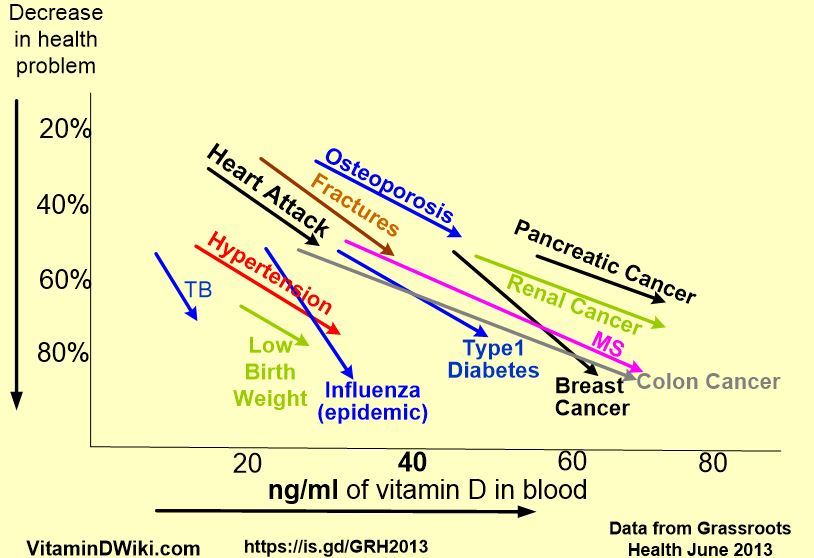
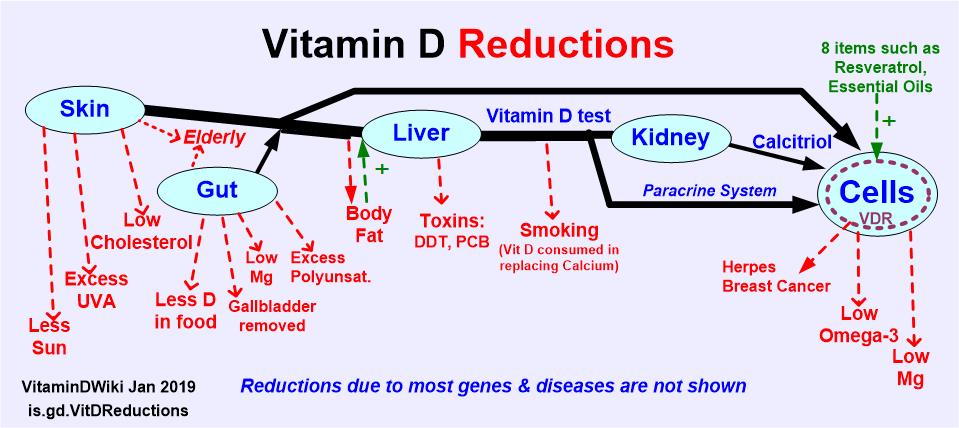
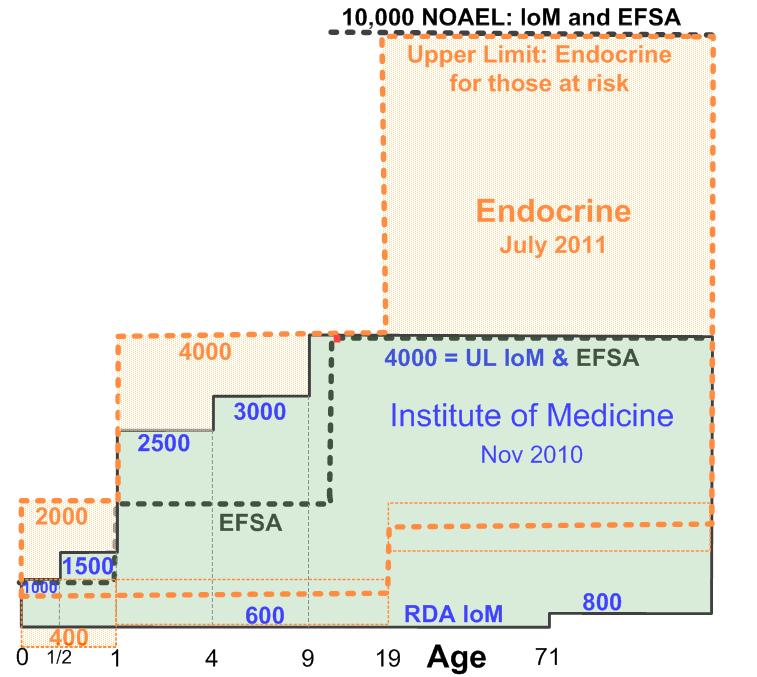
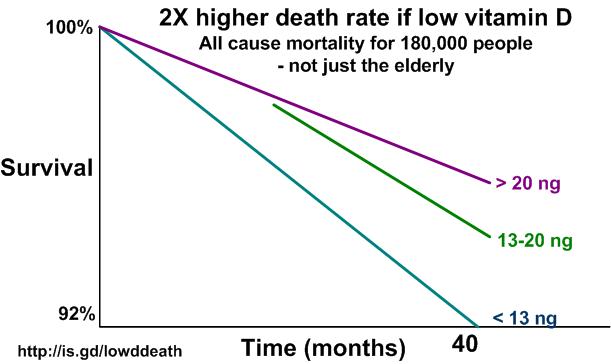


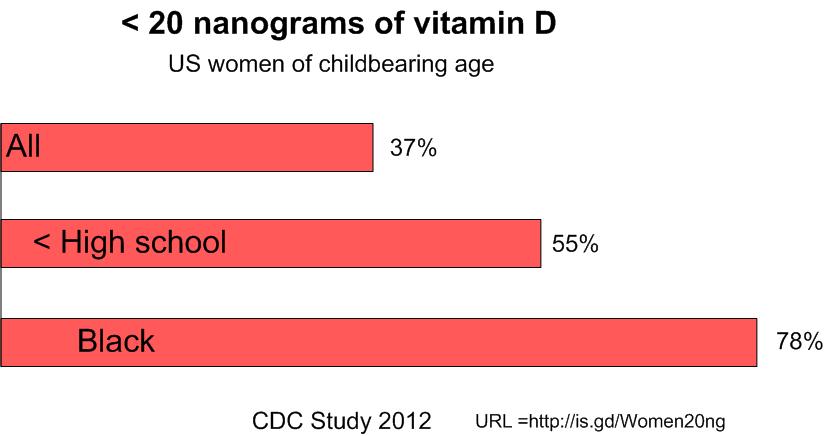
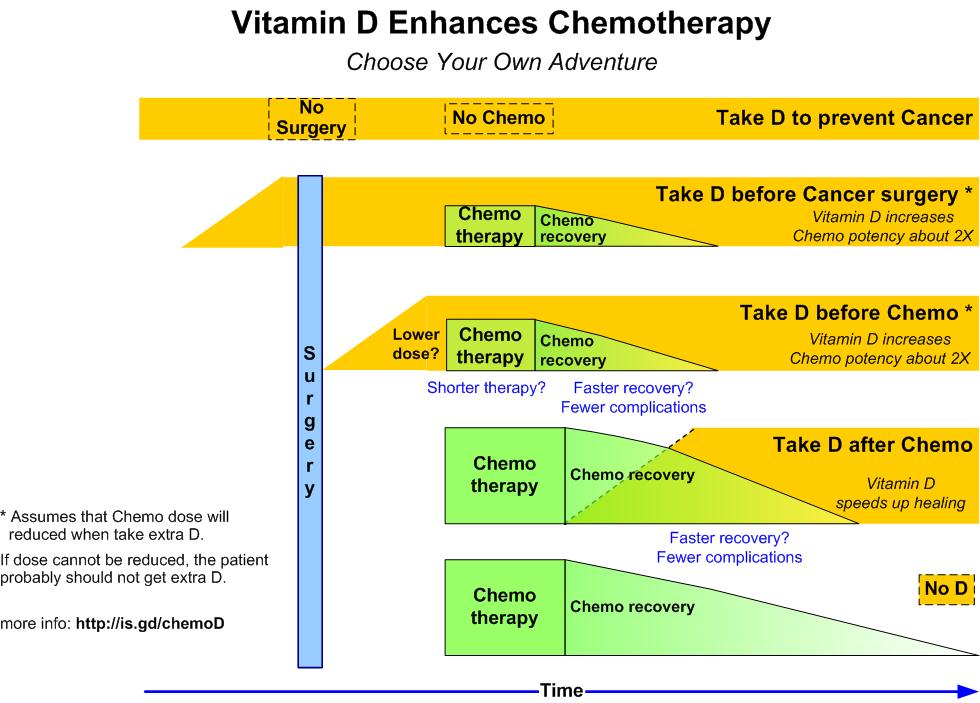


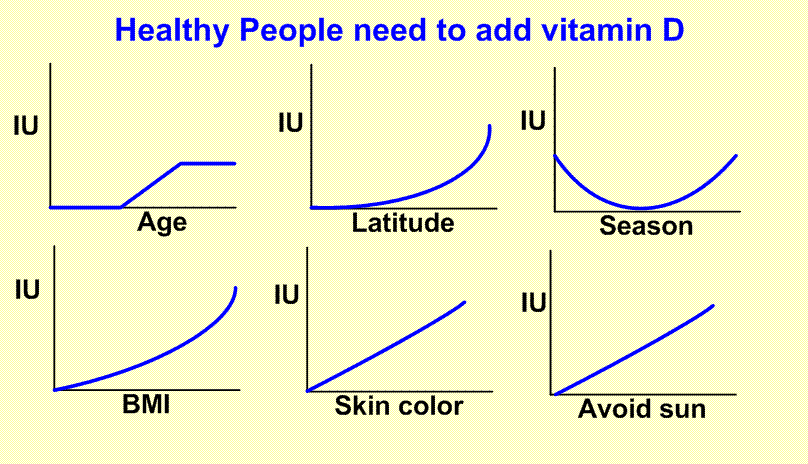


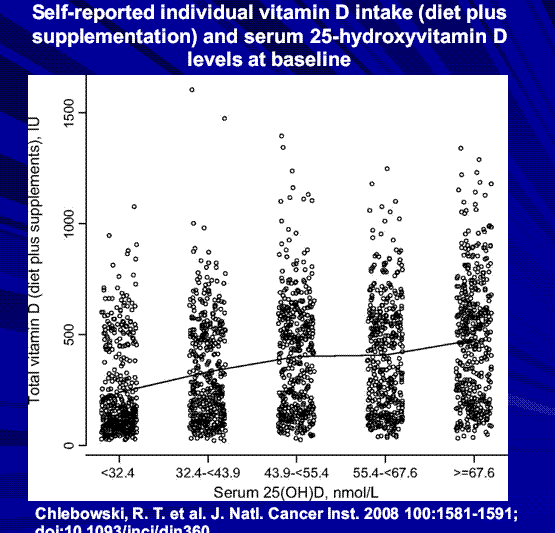 **Still needed**
**Still needed** Delete redundant/obsolete information
Link to overviews, categories
Write summary for each section
Add Graphics
Links to information on the web (Grassroots, etc.)
Reduce/combine the number of entries, so as to reduce the amount of reading material.
See also web
- Study of Vitamin D Supplementation Tailored to Vitamin D Deficiency in Breast Cancer Patients (VITACAL)
- 100,000 IU at intervals depending on initial deficiency
- Brest Cancer at Vitamin D Council updated OMay 2018
- "I have breast cancer. Should I take vitamin D? The answer is a resounding YES"
- The Wrong Approach to Breast Cancer NYT July 2014
- surgery for removal of 2nd (cancerless) breast has increased almost 2X in years
- Survey found that 10% of women believe 2nd breast will also get cancer (actually it is 2-4%)
- Removal of 2nd breast found to extend life in only 1% of women
- Summary by Vitamin D Life - don't do it!
- 3 hours of vigorous exercise weekly cuts Breast Cancer by 20% Nov 2014 - study of 126,000 women
- vs cut Breast Cancer by 80% with 1 minute of vitamin D once every 2 weeks
- 📄 1 page summary of Breast Cancer prevention
- Grassrootshealth - Jan 2016
See also web - other than Vitamin D
Flaxseed Can Prevent And Kill Breast Cancer, Meta-Analysis Reveals GreenMedInfo Sept 2013
- Observational studies: Lowered mortality among breast cancer patients by 32%
- Mammography Is Harmful & Should Be Abandoned, Review Concludes Sept 2015
- "I believe that if screening had been a drug, it would have been withdrawn from the market long ago."
- Mammography screening has been promoted to the public with three simple promises that all appear to be wrong: It saves lives and breasts by catching the cancers early.. . . "
- Breast Cancer Incidence and Mortality - top 10 countries - 2022
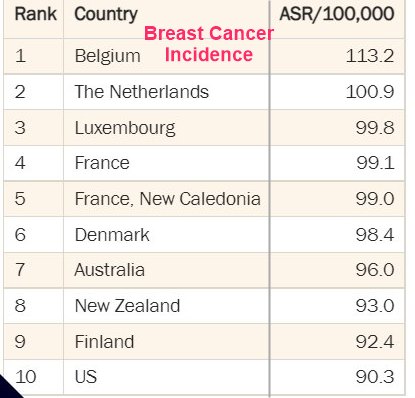
Iceland BC incidence 81/100,000 📄 PDF
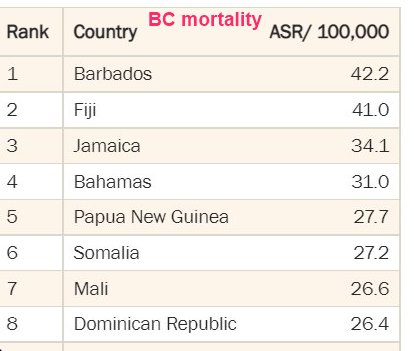
Iceland BC Mortality 13/100,000 📄 PDF
40% less Cancer recurrence after Breast Cancer surgery if NO radiation treatment - Dec 2023
Compelling case for skipping RT in some early breast cancers - MD Edge
Recurrence rate: 1% in 5 years if no radiation therapy vs 1.7% if radiation therapy
"Omitting radiation therapy led to better health-related quality of life and functional and cosmetic outcomes, and the women viewed not having radiation as highly acceptable and appropriate treatment, not undertreatment."
Based on a study in Lancet: Postoperative radiotherapy omission in selected patients with early breast cancer following preoperative breast MRI (PROSPECT): primary results of a prospective two-arm study, which is behind a paywall
Vitamin D Life suspects that the radiation wounds the immune system, making it less likely to be able to fight off future cancers. Wonder if radiation decreases vitamin D levels on a long-term basis?
70 % of women with breast cancer have genes which indicate that Chemo is NOT needed - June 2018
- Good News for Women With Breast Cancer: Many Don’t Need Chemo New York Times
- "The study, called TAILORx, is being published by The New England Journal of Medicine and was to be presented on Sunday (June 3) at a meeting of the American Society of Clinical Oncology in Chicago. The study began in 2006 and was paid for by the United States and Canadian governments and philanthropic groups. Genomic Health, the company that makes the gene test, helped pay after 2016."
- "For every 100 women we were treating, we were probably preventing about 4 distant recurrences.”
- "Of the 9,719 patients with complete follow-up information, 70 percent had scores of 11 to 25 on the gene test. They had surgery and radiation, and then were assigned at random to receive either endocrine therapy alone, or endocrine therapy plus chemo. The median follow-up was more than seven years. Over time, the two groups fared equally well. Chemo had no advantage. After nine years, 93.9 percent were still alive in the endocrine-only group, versus 93.8 percent in those who also got chemo. In the endocrine group, 83.3 percent were free of invasive disease, compared with 84.3 percent who got both treatments. There were no significant differences."
Mammography reduces BC death rate by 1 in 1000, but 10 in 1000 get treatment for no reason - Oct 2016
- This Year’s Mammogram Month Launched With Devastating Report on Harms and Lack of Effectiveness Mercola Oct 2016
- "1 in 1,000 Women Is Saved by Regular Mammogram Screening While 10 Undergo Cancer Treatment for No Reason"

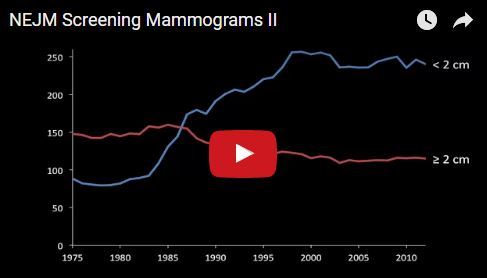
Suggestions to help with Breast Cancer Treatment - Sept 2018
Advising Women Undergoing Treatment for Breast Cancer: A Narrative Review.
J Altern Complement Med. 2018 Sep/Oct;24(9-10):902-909. doi: 10.1089/acm.2018.0150.
Lemanne D1,2,3, Maizes V1.
A majority of women undergoing conventional treatment for breast cancer also undertake complementary and integrative approaches. Practitioners knowledgeable about the evidence base behind common integrative approaches can help patients attain improved quality of life, and at times, improved survival. Evidence-based recommendations include the following:
a plant-based diet for general health after diagnosis, and
carbohydrate restriction for patients with estrogen receptor-positive postmenopausal breast cancer may be prudent.
Other dietary recommendations include a 13-h daily overnight fast. Carefully selected patients may choose to fast the day before and the day of chemotherapy to decrease side effects.
Specific food recommendations include
- avoidance or limitation of alcohol, and liberal culinary use of cruciferous vegetables, coffee, green tea, soy, and flaxseed.
Promising supplements include diindolylmethane and melatonin.
Omega 3 fatty acids may help with bone density in patients on aromatase inhibitors, but may increase chemotherapy resistance.
Findings regarding the usefulness of multivitamins, vitamin D , vitamin C, and vitamin E are weak and/or mixed
different exercise modalities may have different effects and thus play different roles in breast cancer therapy. Aerobic and resistance training combined during breast cancer chemotherapy may confer a survival benefit, while yoga may improve outcome in lymphedema patients.
Current evidence suggests that meditation, yoga, breathing, music therapy, guided imagery, and hypnosis may improve mood and quality of life during breast cancer treatment.
Acupuncture is useful for treating side effects of breast cancer therapies, including hot flushes, aromatase inhibitor-induced joint pain, chemotherapy-induced peripheral neuropathy, and vulvodynia.
Vaginal moisturizers and vaginal rings supplying low-dose estrogen can be useful in the treatment of symptoms of estrogen-deprivation states caused by breast cancer treatments; such symptoms include vaginal dryness, dyspareunia, and sexual dysfunction. Carbon dioxide laser technology can rejuvenate atrophied vaginal mucosa and relieve dyspareunia, allowing avoidance of estrogen therapy. Tertiary sexual health centers are available for referral.
Tamoxifen may be synergistic with Vitamin D
The following is a result of a 1/2 hour look on the internet April 2021
They both prevent Breast Cancer re-occurrence and they help each other
Inhibition of Breast Cancer Cell Growth by Combined Treatment with Vitamin D3 Analogues and Tamoxifen 1994, Free PDF
"Tamoxifen increased the sensitivity of the cells to the vitamin D3 compounds 2- to 4000-fold, which was expressed by a shift to lower median effective concentration values."
The Investigation of the Effects of Tamoxifen and Vitamin D Combination on the Expression of P53, Bcl-2 and Bax and Cell Cycle in Mcf-7 Cell Line Dec 2018
"An effective concentration was found for Tamoxifen. Vitamin D alone did not reduce cell proliferation but decreased cell proliferation with combination. As a result, it was found that therapies using these two agents separately decreased the proliferation of cancer cells and induced cell arrest in the G0/G1 phase in the cell cycle and changed the expressions of p53, BcL-2 and Bax proteins"
📄 Download the PDF from Vitamin D Life
Precautions for Patients Taking Tamoxifen Jan 2018
Vitamin D is not warned against
Breast cancer chemoprevention: beyond tamoxifen April 2001
Breast cancer chemo made more women vitamin D insufficient, even 6 months later– 2019
Lists all of the studies of Vitamin D after diagnosis of Breast Cancer
Breast cancer risk increases by 14% if 1 alcoholic drink daily
Alcohol Is the Breast Cancer Risk No One Wants to Talk About Wired Oct 2021
"14 grams of alcohol, which typically means one 12-ounce beer, one 5-ounce glass of wine, or a 1.5-ounce shot of spirits, such as gin or whiskey."
" By their estimate, 14,000 new cases of breast cancer diagnosed in the US in 2020 could be attributed to prior drinking."
Overview Alcohol and Vitamin D in Vitamin D Life
Getting vitamin D during pregnancy is even more important than avoiding alcohol
Short url = http://is.gd/vitdbc
